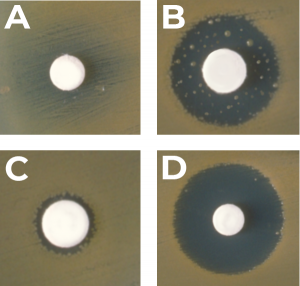Purpose of Test
This AATCC 90 test evaluates the ability of a textile to prevent growth of microorganisms. This estimates the antibacterial efficacy against various concentrations of microorganisms.
This qualitative method determines the bacteriostatic activity on textiles that are treated with antimicrobials and are able to produce a zone of inhibition.
This test has an advantage for testing oddly shaped and non-flat surfaces by embedding the test samples into molden agar before being solidified. This enables optimum contact needed for the test sample and the seeded agar.
Terminology Defined
Antibacterial Activity – Evaluates the protection a textile provides against microorganisms, biological fluids, and aerosols.
Bacteriostatic Activity – The capacity of the textile to resist bacteria growth.
Zone of Inhibition – A circular area where the antibiotic agent was placed in which bacteria doesn’t grow.

Agar Plate – A culture medium used for growing microorganisms.

Test Method
Materials Used for Test
- Test specimens
- Petri dishes
- Bacteria
- Agar plate
Testing Procedure
The test specimen is inoculated and incubated with a growth agar containing test bacteria. After incubation, the zone of inhibition is calculated with the standard test formula for measuring antibacterial activity.
Test Procedure (Summary)
Part 1: Contact of test specimen and agar: The agar is seeded with test bacteria. The test specimen is placed in contact with the growth agar for a given period.
Part 2: Post-incubation period: After the incubation period, the growth of bacteria can be seen on the test specimen. The width of the zone of inhibition is calculated using a specified formula to determine the antibacterial activity.